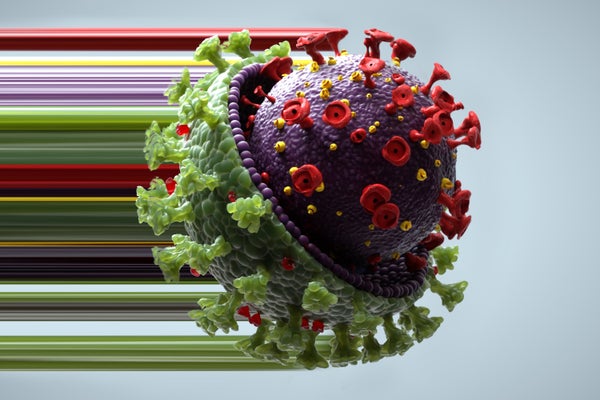When the Omicron strain of SARS-CoV-2, the virus that causes COVID, was surging around the world in February 2022, a man infected with the variant was admitted to Amsterdam University Medical Center. He was 72 years old and had myelodysplastic and myeloproliferative overlap syndrome—a combination of disorders that disrupt proper blood cell production—and lymphoma. In the following 612 days, during which time he was in and out of the hospital, the man continued to test positive for COVID. His case is the longest consecutive COVID infection ever documented, according to a recent report by researchers at the University of Amsterdam.
The report details the evolution of the man’s symptoms and his treatment course and how the Omicron variant developed more than 50 new mutations during the more than 20 months that the individual was infected. The report, which has not yet been published in a scientific journal, was presented this past weekend at the European Society of Clinical Microbiology and Infectious Diseases Global Congress in Barcelona.
“Chronic infections and viral evolution [are] commonly described in [the] literature, and there are other cases of immunocompromised patients who have had [COVID] infections for hundreds of days,” says Magda Vergouwe, an M.D./Ph.D. candidate at the university’s Center for Experimental and Molecular Medicine and lead author of the report. “But this is unique due to the extreme length of the infection..., and with the virus staying in his body for so long, it was possible for mutations to just develop and develop and develop.”
On supporting science journalism
If you're enjoying this article, consider supporting our award-winning journalism by subscribing. By purchasing a subscription you are helping to ensure the future of impactful stories about the discoveries and ideas shaping our world today.
The man, who unfortunately later died from complications of his underlying conditions—not COVID specifically—was first admitted to the hospital when he began experiencing COVID respiratory symptoms, including a cough, shortness of breath and dangerously low blood oxygen levels. He had previously received three shots of the Moderna mRNA COVID vaccine, but his body contained no detectable antibodies. This is likely because of the immune-system-suppressing medications that he was taking to treat his lymphoma and blood condition, Vergouwe says. One of the drugs that he was taking, rituximab, targets abnormal cancer-causing B cells, but in the process it can also destroy their healthy counterparts, which are responsible for creating antibodies against infections.
Doctors prescribed the man multiple COVID treatment regimens, including sotrovimab, a monoclonal antibody that is approved by the European Medicines Agency. He had no measurable clinical response to any of the treatments and could not safely stop any of his other medications that might have been disrupting their effectiveness.
After about a month, however, the man’s initial COVID symptoms waned on their own, and he was discharged to a rehabilitation center and eventually his own home to isolate. But he continued to test positive for COVID throughout those 20 months and at times developed new infections—such as bacterial pneumonia—that were likely complicated by COVID and required additional hospital stays. “It’s important to note that in the end he did not die from his COVID-19,” Vergouwe says. “But he did keep it with him for a very long period of time until then, and this is why we made sure to sample [the virus in his body] as much as we could.”
The researchers analyzed 27 nasal swab samples taken from February 2022 through September 2023 and detected more than 50 new mutations to the original Omicron strain that infected the man. Vergouwe says that while that number can sound shocking, mutations to the SARS-CoV-2 genome are expected to evolve more quickly in those who are immunocompromised (the average mutation rate of the virus is estimated to be two mutations per person per month). What does make these mutations unusual, she notes, is how their features differed vastly from mutations observed in other people with COVID. She hypothesizes that the exceptional length of the individual’s infection and his preexisting conditions allowed the virus to evolve extensively and uniquely.
But it’s unlikely that the 50 new COVID mutations that emerged in this case will spread worldwide, says David Wohl, a professor of medicine in the division of infectious diseases at the University of North Carolina at Chapel Hill, who was not involved in the research. Viral mutation is common; a virus replicating in the human body rarely does so perfectly, and these slightly different versions are deemed mutants. Sometimes the changes to the virus are unhelpful for its survival and aren’t perpetuated. Other times a mutant’s new characteristic is beneficial to the virus and can help it overcome an infected person’s immune response. The mutant becomes a greater threat and can turn into a variant of concern if it can hop from host to host, picking up new traits and defenses against antibodies.
In this case, the viral mutants did not have characteristics that increased its transmission, and there is no documentation that they infected any other people. In order for mutations to successfully spread and become as treacherous as the Omicron and Delta COVID variants, there needs to be a “perfect storm of bad things happening,” Wohl says.
Lengthy COVID infections in immunocompromised people aren’t particularly rare, Vergouwe says, and experts are continuing to survey these cases to track the development of mutations and better understand people’s immune responses.
The best ways people at all risk levels for severe COVID can protect themselves remain staying up-to-date on vaccines and wearing high-quality masks in crowded areas. “New variants can potentially emerge from immunocompromised folks,” Wohl says. “But variants also pop up from others [who are] not immunocompromised as [they] pass the virus to one another. This is part of the nature of the pandemic and how viruses just naturally exist and, unfortunately, evolve.”
